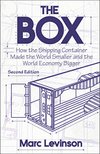The Box: How the Shipping Container Made the World Smaller and the World Economy Bigger - Second Edition with a new chapter by the author
amazon.com
The Box: How the Shipping Container Made the World Smaller and the World Economy Bigger - Second Edition with a new chapter by the author

Experimentation began anew after the war. Amphibious landing ships were recycled as “roll on–roll off” vessels to transport trucks along the coast, improving on techniques originally developed to land troops and tanks in over-the-beach invasions.
Transportation has become so efficient that for many purposes, freight costs do not much affect economic decisions.
In 1933, it joined other railroads to form the International Container Bureau, an organization dedicated to making international container freight practical in Europe.
Malcom McLean’s genius was acknowledged unanimously: almost everyone save the dockworkers’ unions thought that putting freight into containers was a brilliant concept. The idea that the container would cause a revolution in shipping, though, seemed more than a little far-fetched. At best, the container was expected to help ships recover a tiny
... See moreWhether containerships and containerports have reached their maximum efficient size, or even larger and costlier ships and ports could give rise to yet more economies of scale, making it still cheaper and easier to move goods around the globe, is a question of considerable consequence for the world economy.8
The container has enabled logistics centers such as these to prosper by adding value to global supply chains, capturing jobs that were once performed elsewhere, or not at all.
The second important result of shippers’ new power in the 1970s, along with their willingness to defy the shipping cartels, was their embrace of an idea that had been a heresy: the deregulation of transportation.
These new ports, by and large, were privately managed, and in some cases privately financed. Their creation was a deliberate response to the economics of container shipping, in which keeping the ship moving is what matters most. Only the biggest ports are worth a time-consuming stop: in 2014, 46 percent of world container shipments moved through
... See moreContainer shipping thrives on volume: the more containers moving through a port or traveling on a ship or train, the lower the cost per box. Places with lower demand or poorer infrastructure will face higher transport costs and will be far less attractive manufacturing sites for the global market. In the 1970s and 1980s, when many U.S. industrial
... See more